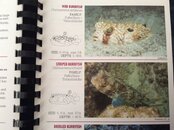The REEF database can be accessed to produce several different types of reports. The following link is to a short YouTube video produced recently by REEF for accessing a geographic area report.
Geographic Area Report
Using the geographic area reports, distribution reports, and access to my data on REEF produced some distribution information for Striped and Web Burrfish. Full disclosure, BHB has approximately 2650 surveys submitted. Approximately 2150 expert surveys, and 500 novice surveys. 1450 expert surveys for BHB have been submitted by me.
This means the expert survey numbers are skewed heavily in favor of my observations. For example, the Striped Burrfish occurs in 8.8% of all expert surveys at BHB. But in my surveys the Striped Burrfish occurs 5.6% of the time. Using a weighted average, that means all the other expert surveyors observe Striped Burrfish 15% of the time. A possible explanation for the disparity is that I dive the west side 90% of the time. I know a spot on the eastside where I can usually find Striped Burrfish at a far greater rate than 5.6%, but I am hardly ever over there.
So some of the other numbers. If we check the whole tropical western Atlantic Ocean for observations of Web Burrfish, they occur only .6% of the time, once in every 160 surveys submitted, for a total of 1140 times out 190,000 surveys. The Striped Burrfish occurs in even less frequently, .35% of the time, once in every 285 times, for a total of 660 times out 190,000 surveys.
The Striped Burrfish occurs 1.0% of the time in Florida observations, and 1.0% of time in Gulf of Mexico observations. It is extraordinarily rare in the in Caribbean occurring at little as .02% of the time. This is confirmed in a search of inaturalist. The map function in inaturalist shows where 2396 observations of Striped Burrfish are recorded.
Map Of Striped Burrfish Observations . Many of the observations are well north of Florida extending all the way to Massachusetts. Clearly a tropical to temperate water fish.
Although the Web Burrfish occurs in total more than the Striped Burrfish, the Web Burrfish only occurs .1% in Florida, and .45% of the time at BHB. It occurs most frequently in the Lesser Antilles 2.3% of the time and in the ABC islands (Bonaire) 1.2% of the time, and is mostly absent in the rest of the tropical western Atlantic. Again this can be confirmed in a search of Web Burrfish in inaturalist. There are 81 observations the maps shows most of the observations in the Lesser Antilles and around Bonaire, and only a few to the north in Florida.
Map of Web Burrfish Observations Clearly a tropical water fish only. Interesting, is the disparity in observations recorded in inaturalist vs. REEF for the two species.. My observation of the Web Burrfish at BHB is .22% of time.
Either way, BHB is a hot spot for these two species, as it for some many other species, like the Lined Seahorse. As far as above I have to go with the Striped Burrfish identification for the image poster by
@tarponchik. Below are pictures of a Striped Burrfish (top) taken at BHB and Web Burrfish (bottom) taken at LBTS in September.





